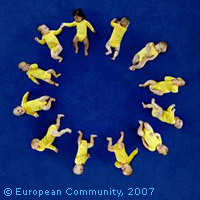EU project finds gene causing childhood asthma
An EU-funded project has identified a previously unknown gene that increases the risk of children developing asthma. Until now, scientists had only been able to come up with treatments for the symptoms of the condition. But new developments in genomics and bioinformatics have allowed the team to compare genetic markers in asthmatic and non-asthmatic children. The discovery of the gene ORMDL3 could lead to improved prevention and diagnosis of asthma, and possibly a new therapy. The GABRIEL project is funded under the 'Lifesciences, genomics and biotechnology for health' section of the EU's Sixth Framework Programme (FP6). It involves over 150 scientists from 14 European countries. 'Asthma is the major chronic childhood illness in Europe, costing the European Community more than €3 billion each year. Although effective therapies for mild asthma exist, the 10% of children with the severe disease account for 60% of this expense,' said project coordinator Professor Bill Cookson of Imperial College London in the UK. The team pinpointed ORMDL3 after comparing over 300,000 genetic markers in thousands of asthmatic children with those of children without the condition. Comparisons showed that several genetic variations clearly influence the expression of the gene ORMDL3, and raise the risk of asthma in infancy. The initial study was replicated in additional case groups, and the results confirmed the original findings. The results came only just over a year into the GABRIEL project, and with other studies planned and ongoing, further insights into childhood asthma are expected. In addition to examining genetic and environmental interactions, GABRIEL will look for a molecular basis for environmental factors that can increase the risk of industrial asthma. The team also hopes to identify the agents that appear to protect against asthma in rural and farming communities. 'One particular area we will be looking at is the 'hygiene hypothesis', a theory which argues a lack of exposure to microbes in early childhood may cause an increased risk of developing asthma and allergies. Earlier work has indicated this may the case, but we hope the scale of GABRIEL will allow us to properly test the hypothesis and to identify the responsible agents,' says Professor Erika von Mutius, joint project coordinator, from Munich University.



